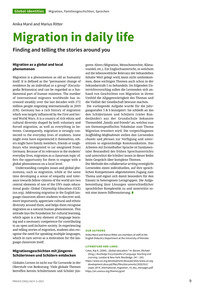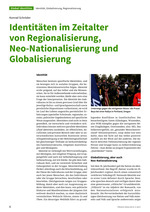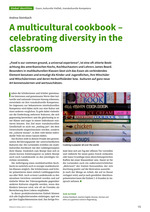Migration in daily life Finding and telling the stories around you
Bei Bezahlung über Paypal und Kreditkarte können keine Sonderkonditionen gewährt werden.
Melden Sie sich dafür bitte mit Ihrem Kundenkonto an.
Frische Ideen für den Englischunterricht!
Ihr Wegweiser zu den wichtigsten Seiten von PRAXIS ENGLISCH:
Mehr zur Zeitschrift| Produktnummer | OD200041014976 |
| Schulform | Hauptschule, Realschule, Realschule plus, Sekundarschule, Mittelschule, Regelschule, Regionale Schule, Oberschule, Integrierte Gesamtschule, Gymnasium, Sekundarstufe II, Berufsgrundbildungsjahr, Berufsfachschule, 2-jährige |
| Schulfach | Englisch |
| Klassenstufe | 5. Schuljahr bis 7. Schuljahr |
| Seiten | 7 |
| Erschienen am | 01.06.2021 |
| Dateigröße | 70,7 kB |
| Dateiformat | PDF-Dokument |
| Autoren/ | Anika Marxl, Marius Ritter |
| Schlagworte | Familiengeschichten, Migration, Sprechen |
Migration as a global and local phenomenon
Migration is a phenomenon as old as humanity itself. It is defined as the “permanent change of residence by an individual or a group” (Encyclopedia Britannica) and can be regarded as a fundamental part of human existence. The number of international migrants worldwide has increased steadily over the last decades with 272 million people migrating internationally in 2019 (UN). Germany has a rich history of migration which was largely influenced by the First and Second World Wars. It is a country of rich ethnic and cultural diversity shaped by both voluntary and forced migration, as well as everything in between. Consequently, migration is strongly connected to the everyday lives of students. Some might even have experienced it themselves, others might have family members, friends or neighbours who immigrated to (or emigrated from) Germany. Because of its relevance in the students’ everyday lives, migration as a classroom topic offers the opportunity for them to engage with a global phenomenon on a local level.














